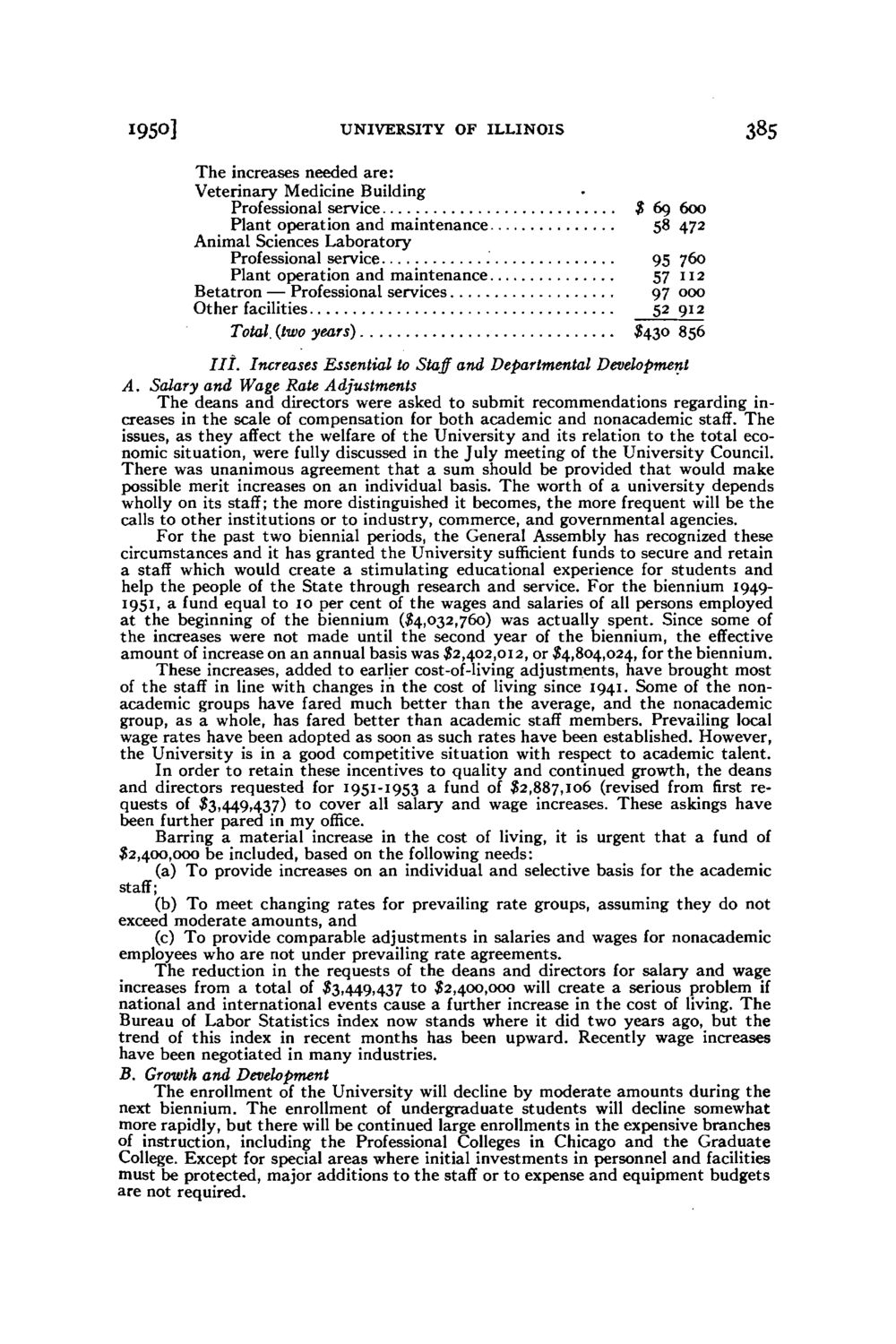| |
| |
Caption: Board of Trustees Minutes - 1952
This is a reduced-resolution page image for fast online browsing.

EXTRACTED TEXT FROM PAGE:
I9SO UNIVERSITY OF ILLINOIS The increases needed are: Veterinary Medicine Building Professional service Plant operation and maintenance Animal Sciences Laboratory Professional service Plant operation and maintenance Betatron — Professional services Other facilities Total, {two years) 385 $ 69 600 58 472 95 760 57 " 2 97 000 52 9'2 8430 856 III. Increases Essential to Staff and Departmental Development A. Salary and Wage Rate Adjustments T h e deans and directors were asked to submit recommendations regarding increases in the scale of compensation for both academic and nonacademic staff. The issues, as they affect the welfare of the University and its relation to the total economic situation, were fully discussed in the July meeting of the University Council. There was unanimous agreement that a sum should be provided that would make possible merit increases on an individual basis. The worth of a university depends wholly on its staff; the more distinguished it becomes, the more frequent will be the calls to other institutions or to industry, commerce, and governmental agencies. For the past two biennial periods, the General Assembly has recognized these circumstances and it has granted the University sufficient funds to secure and retain a staff which would create a stimulating educational experience for students and help the people of the State through research and service. For the biennium 19491951, a fund equal to 10 per cent of the wages and salaries of all persons employed at the beginning of the biennium (#4,032,760) was actually spent. Since some of t h e increases were not made until the second year of the biennium, the effective amount of increase on an annual basis was 82,402,012, or 84,804,024, for the biennium. These increases, added to earlier cost-of-living adjustments, have brought most of the staff in line with changes in the cost of living since 1941. Some of the nonacademic groups have fared much better than the average, and the nonacademic group, as a whole, has fared better than academic staff members. Prevailing local wage rates have been adopted as soon as such rates have been established. However, the University is in a good competitive situation with respect to academic talent. In order to retain these incentives to quality and continued growth, the deans and directors requested for 1951-1953 a fund of 82,887,106 (revised from first requests of S3,449,437) to cover all salary and wage increases. These askings have been further pared in my office. Barring a material increase in the cost of living, it is urgent that a fund of 82,400,000 be included, based on the following needs: (a) To provide increases on an individual and selective basis for the academic staff; (b) To meet changing rates for prevailing rate groups, assuming they do not exceed moderate amounts, and (c) To provide comparable adjustments in salaries and wages for nonacademic employees who are not under prevailing rate agreements. The reduction in the requests of the deans and directors for salary and wage increases from a total of 83,449,437 to 82,400,000 will create a serious problem if national and international events cause a further increase in the cost of living. T h e Bureau of Labor Statistics index now stands where it did two years ago, but the trend of this index in recent months has been upward. Recently wage increases have been negotiated in many industries. B. Growth and Development The enrollment of the University will decline by moderate amounts during the next biennium. The enrollment of undergraduate students will decline somewhat more rapidly, but there will be continued large enrollments in the expensive branches of instruction, including the Professional Colleges in Chicago and the Graduate College. Except for special areas where initial investments in personnel and facilities must be protected, major additions t o t h e staff or to expense and equipment budgets are not required.
| |